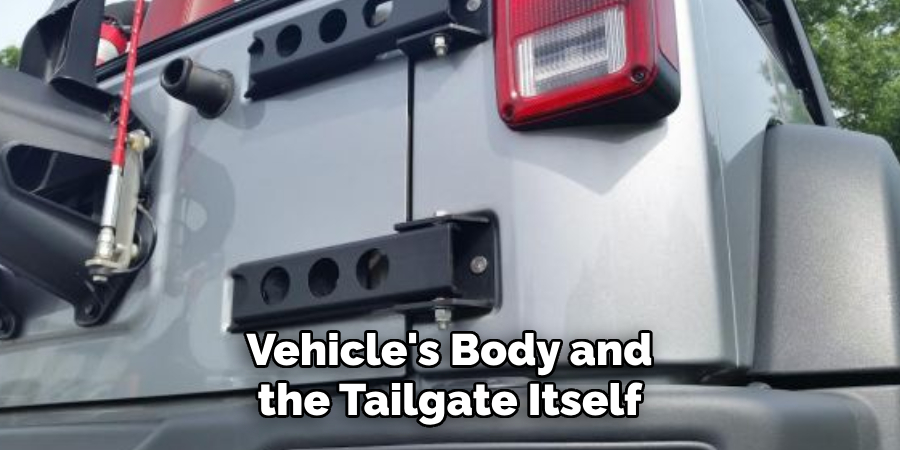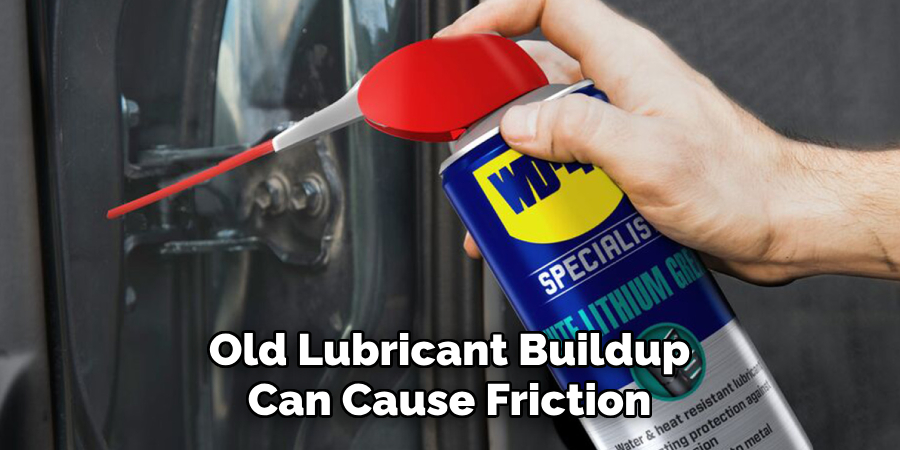Maintaining your Jeep is crucial to ensure its longevity and optimal performance on and off the road. One often overlooked yet essential aspect of Jeep care is lubricating the tailgate hinges.

The tailgate hinge, responsible for smooth opening and closing of the tailgate, can become stiff and prone to rust over time, hindering its functionality. Lubricating the tailgate hinge not only prevents corrosion but also ensures effortless operation.
In this guide, we’ll explore the simple yet effective steps for how to lube jeep tailgate hinge. Whether you’re a seasoned off-roader or new to Jeep maintenance, learning how to properly lubricate the tailgate hinge is a valuable skill that will enhance your Jeep ownership experience.
By following these steps, you’ll keep your Jeep’s tailgate operating smoothly, reduce wear and tear, and maintain the overall integrity of your vehicle for years to come. Let’s dive into the process of keeping your Jeep’s tailgate hinge in top condition.
Importance of Maintaining Jeep’s Tailgate Hinge
Regular maintenance of your Jeep’s tailgate hinge is not merely about preventative care; it’s about preserving the experience and adventure that Jeep stands for. A well-lubricated hinge prevents the frustrating creaks and squeaks that can disrupt the tranquility of a drive or the efficiency of loading and unloading gear.
Moreover, neglect in tending to the tailgate hinge can lead to corrosion and rust build-up, potentially leading to costly repairs or replacements. Keeping this joint in pristine condition ensures that your tailgate remains reliable, functional, and rady for any journey you embark upon. So, let’s get started on how to lube jeep tailgate hinge.
Understanding the Tailgate Hinge
The tailgate hinge is a crucial component that connects the tailgate to the body of the Jeep, allowing it to swing open and closed with ease. It consists of a pivoting mechanism that typically includes a pin and bushing.
Over time, exposure to the elements, as well as dirt and debris from the road or trails, can lead to the accumulation of grime inside the hinge. This can cause increased friction, resulting in squeaking noises during operation and, eventually, difficulty in opening or closing the tailgate.
Understanding the structure and function of the tailgate hinge is imperative for effectively applying lubricant and ensuring its longevity. With this understanding, Jeep owners can be proactive in maintenance and avoid the inconvenience of a malfunctioning tailgate during their off-road adventures or daily use.
Components of the Tailgate Hinge
The tailgate hinge mechanism is comprised of several key components that work together to allow the tailgate to open and close smoothly. The primary elements include:

- Hinge Brackets: Mounted to the vehicle’s body and the tailgate itself, these brackets provide the foundational support for the hinge mechanism.
- Pivot Pins: These pins serve as the central axis for the hinge, enabling the tailgate to swing open and shut.
- Bushing or Bearings: These are typically inserted around the pivot pins to reduce friction and wear between the moving metal components.
- Grease Fittings (if applicable): Some hinges are equipped with grease fittings to facilitate easy lubrication without disassembly.
- Protective Caps: Designed to cover and protect the hinge from direct exposure to water, dirt, and other contaminants.
Understanding each of these components and their function is crucial when it comes to proper lubrication and maintenance of the tailgate hinge. Regularly inspecting these parts for wear or damage and keeping them well-lubricated will ensure that your tailgate hinge remains in good working condition.
Materials Needed
To properly lube the tailgate hinge of your Jeep, you’ll need to gather a few essential items. Having the right materials on hand will make the lubrication process straightforward and effective. Here’s what you’ll need:
- Penetrating Oil: A high-quality penetrating oil is essential for loosening rusty or stiff hinges.
- White Lithium Grease: This type of grease is ideal for long-term lubrication of the hinge components.
- Rag: A clean rag will be useful for wiping away any excess oil or grease and cleaning the hinge area.
- Gloves: Optional but recommended to protect your hands from grease and grime.
- Safety Glasses: Protect your eyes from any potential spray or debris.
- Wire Brush: This will help in removing rust and dirt buildup from the hinge and surrounding areas.
Gathering these materials before you start will help ensure a smooth and efficient lubrication process for your Jeep’s tailgate hinge.
10 Methods How To Lube Jeep Tailgate Hinge
1. Gather the Necessary Materials:
Before beginning the lubrication process, gather all the materials you’ll need. This includes a degreaser or cleaner, a soft cloth or brush for cleaning, a suitable lubricant such as white lithium grease or silicone spray, gloves to protect your hands, and a step stool or ladder if necessary.

It’s important to have all of these materials on hand before starting the lubrication process to ensure a smooth and efficient experience. However, if you are missing any of these materials, you can always make a quick trip to the hardware store to pick them up.
2. Park Your Jeep on a Flat Surface:
Ensure your Jeep is parked on a flat surface and engage the parking brake to prevent any movement during the lubrication process. Additionally, make sure the tailgate is closed securely before starting.
Once your Jeep is parked and secured, it’s time to start the lubrication process. Lubricating your Jeep’s parts regularly is crucial for maintaining its optimal performance and lifespan. It helps reduce friction between moving parts, preventing wear and tear, and extends their longevity.
Before you begin, gather all the necessary tools and materials such as lubricants, grease gun, rags, and a mechanic’s creeper (optional). It’s also essential to refer to your Jeep’s manual for specific lubrication points and recommended lubricants.
3. Clean the Hinge Area:
Use a degreaser or cleaner and a soft cloth or brush to thoroughly clean the tailgate hinge area. Remove any dirt, debris, or old lubricant buildup from the hinge mechanism to ensure proper lubrication. Make sure to clean both the tailgate and body side hinge areas for best results.
It is important to regularly clean the hinge area of your vehicle’s tailgate to ensure smooth operation. Dirt, debris, and old lubricant buildup can cause friction and wear on the hinge mechanism, leading to potential issues with opening and closing your tailgate.

When cleaning the hinge area, it is important to use a degreaser or cleaner that is safe for use on automotive surfaces. This will help prevent any damage to the paint or other materials around the hinge area.
4. Inspect for Damage:
While cleaning the hinge area, inspect it for any signs of damage or excessive wear. Look for cracks, rust, or any other issues that may need to be addressed before lubricating the hinge. If you notice any damage, consult a professional for repairs or replacement.
Though lubrication can help prevent wear and tear, it is not a fix for existing damage. If the hinge is severely damaged, it may need to be replaced altogether. Additionally, check the screws and bolts that hold the hinge in place. Tighten any loose ones to ensure proper functionality.
5. Choose the Right Lubricant:
Select a suitable lubricant for your Jeep’s tailgate hinge. White lithium grease and silicone spray are commonly recommended options due to their ability to provide long-lasting lubrication and protection against rust and corrosion. However, there are a few key differences between the two that you should consider before making your decision.
White lithium grease is a heavy-duty lubricant that is ideal for use on metal components. It has excellent water and heat resistance, making it suitable for both indoor and outdoor use. This makes it a great choice for tailgate hinges that are exposed to different weather conditions.
It also has a high melting point, meaning it can withstand high temperatures without breaking down or evaporating. Additionally, white lithium grease contains additives that promote lubrication and prevent wear and tear on the hinge mechanism.

6. Apply the Lubricant:
Once the hinge area is clean and free of debris, apply the chosen lubricant generously to the hinge mechanism. Be sure to spray or apply the lubricant to all moving parts of the hinge, including the pivot points and joints. You can use a small brush or cloth to help distribute the lubricant evenly.
If you are using a spray lubricant, be sure to cover any surrounding areas with a rag or towel to avoid overspray. This will prevent the lubricant from getting on other surfaces and potentially causing damage.
After applying the lubricant, open and close the hinge several times to ensure that it has been properly distributed and is working smoothly. If necessary, add more lubricant to any areas that still feel stiff or squeaky.
7. Work the Tailgate:
After applying the lubricant, open and close the tailgate several times to distribute the lubricant evenly throughout the hinge mechanism. This will help ensure smooth operation and optimal performance of the tailgate hinge.
In addition to lubricating the hinge, it is also important to regularly clean and inspect the tailgate for any signs of wear or damage. This includes checking for rust, cracks, and loose screws or bolts. If any issues are found, they should be addressed immediately to prevent further damage.
To keep your tailgate in top condition, it is recommended to clean it with a mild soap and water solution, followed by a coat of wax to protect the paint and metal.
If your tailgate has a locking mechanism, it is important to regularly test and lubricate it as well. This will help prevent any issues with unlocking or opening the tailgate.

8. Wipe Off Excess Lubricant:
Use a clean cloth to wipe off any excess lubricant that may have accumulated on the hinge area or surrounding surfaces. This will help prevent attracting dirt and debris and keep your Jeep looking clean and well-maintained. Additionally, excess lubricant can also cause unwanted buildup and potentially interfere with the proper functioning of your Jeep’s hinges.
However, be careful not to wipe off too much as the hinges still need a thin layer of lubricant for smooth operation. Make sure to use a lint-free cloth to avoid leaving behind any fibers or residue.
9. Perform Regular Maintenance:
Make lubricating the tailgate hinge a part of your regular Jeep maintenance routine. Depending on your driving conditions and usage, it’s recommended to lubricate the hinge every few months or as needed to keep it in optimal condition.
In addition to lubricating the tailgate hinge, there are other regular maintenance tasks that should be performed on your Jeep. This includes changing the oil and filter every 3,000-5,000 miles, rotating the tires every 6,000-8,000 miles, and checking and replacing any worn belts or hoses. These routine maintenance checks can prevent larger issues down the road and keep your Jeep running smoothly.
It’s also important to regularly inspect and clean your Jeep’s electrical connections, as well as check the battery for corrosion. This can help prevent any potential electrical issues and ensure that your Jeep starts up without any problems.
10. Monitor Performance:
After lubricating the tailgate hinge, monitor its performance over time. Pay attention to any signs of stiffness, squeaking, or difficulty opening and closing the tailgate, as these may indicate the need for additional lubrication or maintenance.
It is also important to regularly clean the hinge and surrounding area to prevent build-up of dirt and debris, which can affect performance. Additionally, it is recommended to periodically inspect the tailgate hinge for any signs of wear or damage, and replace if necessary.

Regular maintenance and monitoring of the tailgate hinge can help prolong its lifespan and ensure smooth operation. In case of any issues, it is best to address them promptly to prevent further damage and avoid potential safety hazards. It is also beneficial to follow the manufacturer’s recommendations for maintenance and lubrication intervals.
Testing and Maintenance
To ensure the longevity and reliability of your Jeep’s tailgate hinge, it is crucial to implement a testing and maintenance routine. Start by performing a stress test on the hinges by applying gentle pressure to the tailgate when open to simulate wind stress or the weight of accessories.
Listen for any unusual noises or loose movements that may indicate wear or weakening of the mechanism. Carry out this test periodically, especially after off-road adventures or heavy usage.
In addition to stress testing, make a habit of visually inspecting the tailgate hinge and surrounding areas for signs of corrosion or excessive wear. Look for any discoloration or material degradation that might compromise the integrity of the tailgate system. Corrosion can set in quickly, especially in harsh climates with road salt or in coastal areas with salty air, so being proactive is key.
Develop a maintenance schedule based on your specific use-case scenarios. For instance, if you frequently drive in wet or muddy conditions, increase the frequency of lubrication and inspections. Document each maintenance activity in a log to track the health and servicing of your tailgate over time.
Troubleshooting Tailgate Hinge Issues
If you encounter issues with your Jeep’s tailgate after performing regular maintenance, here are some troubleshooting steps:
- Stiffness or Squeaking: If the tailgate hinge remains stiff or begins to squeak after lubrication, double-check that you’ve applied enough lubricant to all the necessary areas. If the problem persists, inspect for dirt or rust that may be impeding movement.
- Tailgate Won’t Close Properly: This might be due to misalignment of the tailgate or a problem with the surrounding frame. Examine the alignment, and if necessary, adjust the tailgate or the latch.
- Locking Mechanism Issues: If the tailgate lock isn’t functioning smoothly, apply a specific lock lubricant to the mechanism. If problems continue, the lock assembly may need to be replaced.
- Visible Wear or Damage: Any cracks, rust, or significant wear on the hinge is a sign that the part may need replacement. Consult your Jeep’s dealership or a professional mechanic for further assistance.

Should these basic troubleshooting tips not resolve your issues, or if you are uncomfortable performing these checks yourself, it is advisable to seek professional help from a certified mechanic. Remember, delaying necessary repairs can lead to more significant problems down the road.
Conclusion
In conclusion, properly lubricating your Jeep’s tailgate hinge is a simple yet essential maintenance task that can significantly enhance the longevity and functionality of your vehicle.
By following the recommended methods of how to lube jeep tailgate hinge, including thorough cleaning, selecting the appropriate lubricant, and performing regular maintenance, you can ensure smooth operation and prevent premature wear and tear of the tailgate hinge mechanism.
Consistent lubrication not only improves the overall performance of your Jeep but also helps prevent costly repairs and ensures a hassle-free driving experience on and off the road. Remember to monitor the hinge’s performance over time and address any signs of stiffness or difficulty in operation promptly.
By incorporating the proper lubrication of your Jeep’s tailgate hinge into your routine maintenance schedule, you can enjoy years of trouble-free driving and adventure with your beloved vehicle.

About
JeepFixes Team is a skilled author for Jeep Fixes, bringing 6 years of expertise in crafting a wide range of jeep fixes. With a strong background in jeep fixes work, JeepFixes Team’s knowledge spans various types of fixtures, from decorative pieces to functional hardware, blending precision with creativity. His passion for jeep fixes and design has made him a trusted resource in the industry.
Professional Focus:
Expert in Jeep Fixes : JeepFixes Team aesthetic specializes in creating durable and innovative jeep fixes, offering both appeal and functionality. His work reflects a deep understanding of jeep fixes techniques and materials.
Sustainability Advocate : He is dedicated to using sustainable practices, ensuring that every fixture is crafted with eco-friendly methods while maintaining high-quality standards.
In his writing for jeep fixes, JeepFixes Team provides valuable insights into the latest trends, techniques, and practical advice for those passionate about jeep fixes, whether they are professionals or DIY enthusiasts. His focus on combining artistry with engineering helps others discover the true potential of jeep in design.
